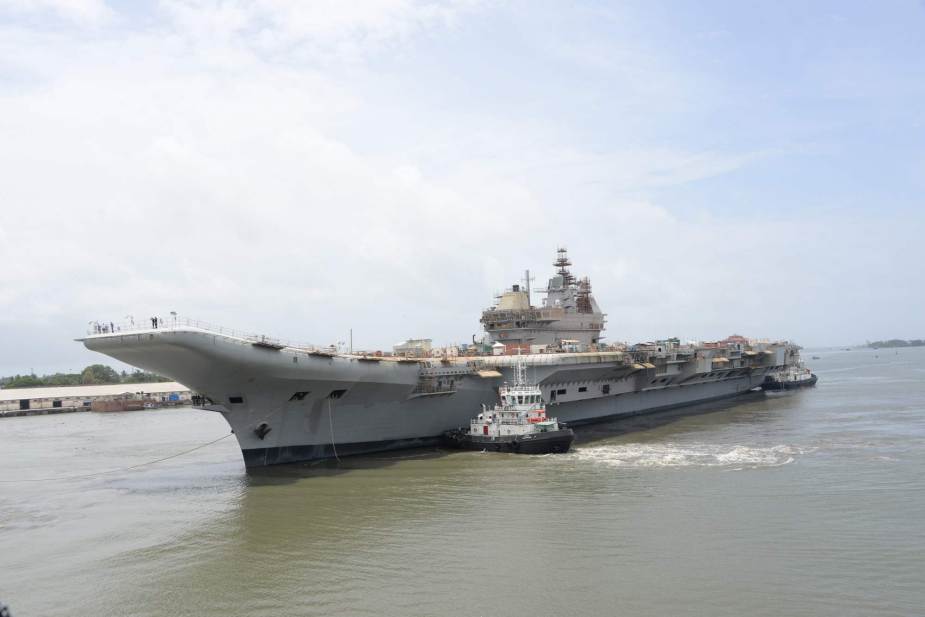Breaking news
India to start basin trials with its local-made INS Vikrant aircraft carrier.
According to information published by Indian newspaper websites, India will start this month, basin trials with its local-made INS Vikrant aircraft carrier also named IAC-1 (Indigenous Aircraft Carrier), including tests of propulsion and electrical systems. The design of the new Indian aircraft carrier was started in 1999 and the keel was laid in February 2009.
Follow Navy Recognition on Google News at this link
 India's first indigenous aircraft carrier INS VIKRANT(IAC1). (Picture source Twiter account Radiance)
India's first indigenous aircraft carrier INS VIKRANT(IAC1). (Picture source Twiter account Radiance)
The INS Vikrant aircraft carrier was designed by the Directorate of Naval Design of the Indian Navy and the first warship to be built by Cochin Shipyard. She was floated out of its dry dock on 29 December 2011 and was launched on 12 August 2013.
The INS Vikrant aircraft carrier is powered by four General Electric LM2500+ gas turbines driving two shafts. She can reach a top speed of 28 knots (52 km/h; 32 mph) with a maximum cruising range of 8,000 nautical miles (15,000 km; 9,200 mi).
The INS Vikrant will have an overall length of 262 m and a beam of 62 m and its displacement will be 40,000t. She can accommodate 1,600 personnel including ship company, airgroup and troops.
India opted for a three-carrier fleet consisting of one carrier battle group stationed on each seaboard, and a third carrier held in reserve, in order to continuously protect both its flanks, to protect economic interests and mercantile traffic, and to provide humanitarian platforms in times of disasters, since a carrier can provide a self-generating supply of fresh water, medical assistance or engineering expertise to populations in need for assistance.
The INS Vikrant aircraft carrier will be able to operate 36 to 40 aircraft including 26 Russian-made MiG-29K, a Russian-made supersonic carrier-based fighter. The MiG-29K is drastically modified from the Mikoyan MiG-29M for naval operations. The airframe and undercarriage are reinforced to withstand the stress experienced upon landing. Folding wings, an arrestor hook, and catapult attachments were added for carrier operation. Other aircraft will include Russian-made Ka-31, Westland Sea King, HAL Dhruv helicopters, and the indigenous light combat aircraft.
Currently, the Indian Navy has 45 Russian MiG-29K aircraft and its officials had stated that there will not be enough aircraft to operate from both carriers. The Indian has also shown interest in the acquisition of the American F-18 Super Hornet or the naval version of the French Rafale.
Citing the naval-technology website, the 110,000 sq ft flight deck of INS Vikrant will feature two take-off runways and a landing strip equipped with three arrester wires. The STOBAR (short take-off but arrested recovery) system on an angled flight deck is used to launch and recover an aircraft from the deck of an aircraft carrier. IAC-2 will be fitted with steam catapults rather than STOBAR to launch fourth-generation aircraft.
The INS Vikrant aircraft carrier will be armed with four Otobreda 76 mm (3 in) dual-purpose cannons, 2 x32 cells VLS (Vertical Launching systems) able to launch Barak 1 and Barak 8 surface-to-air missiles and AK-630, Russian fully automatic naval close-in weapon system based on a six-barreled 30 mm rotary cannon.
The INS Vikrant aircraft carrier will be equipped with EL/M-2248 MF-STAR multifunction active electronically scanned array naval radar and a Selex RAN-40L naval 3D L band search radar developed by Italian Company Leonardo.





























